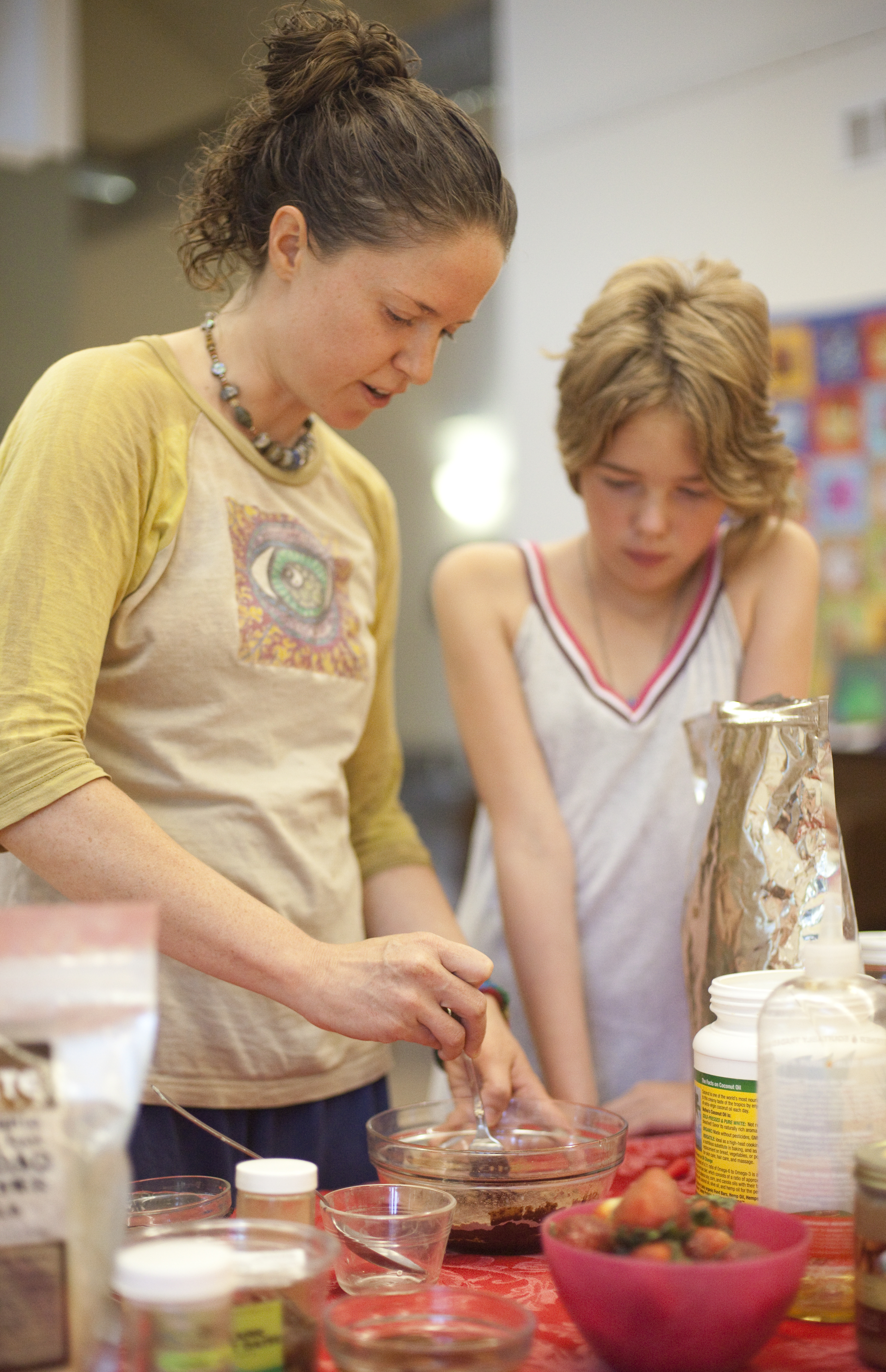Diet not one-size-fits-all

Chloe Callan, 11, watches as Aly Young stirs a bowl of chocolate made from cacao powder, agave nectar and coconut oil as she prepares for a monthly gathering of the Lawrence Raw Foods Community on June 7 at Delaware Street Commons, 1222 Del.
Dietary lifestyles
There are many dietary lifestyles, and endless combinations of them. Here are basic descriptions of a few you many have heard of.
• Omnivore: Eats everything.
• Pollotarian: Eats chicken or poultry, but not red meat.
• Pescetarian: Eats fish but not other types of meat.
• Ovo-lacto-vegetarian: Most common type of vegetarian, eats milk and egg products but no flesh meat.
• Vegan: Eats only plants. No animal by-products, such as eggs, milk or, for the strictest vegans, honey.
• Fruitarian: Eats only fruits, nuts and seeds. No animal products, vegetables or grains.
• Raw foodist: Eats only uncooked, unprocessed food. Commonly vegan, but some subsets eat raw meat.
• Paleo, or caveman: Inspired by hunter-gatherer ancestors, eats only meats, fruits and vegetables. No refined sugar, grains, dairy or legumes.
• Flexitarian: A vegetarian who occasionally eats meat, according to the American Dialect Society (which voted flexitarian one of its most useful words in 2003).
The vast majority of Americans are omnivores, subsisting on the traditional four food groups — all four of them.
But what do we call the people who eat only three, two or one of those groups? And why do they choose to eat differently from the mainstream?
The combinations — as it only takes a few Lawrence vegetarians to illustrate — are practically endless.
“Diet has to fit you, just like clothes do,” said Nancy O’Connor, the Merc’s director of education and outreach and an ovo-lacto-vegetarian. “Eating can be a complicated, conscious decision if you really think about it.”
Dietary combinations
Vegetarian or partially vegetarian diets abound, ranging from vegans — who eat no animal byproducts, not even honey — to pesco-pollo-vegetarians — who don’t eat red meat but do eat fish and chicken.
There are even diets that include meat but remove other food groups, such as paleo — no dairy or grains.
O’Connor said ovo-lacto-vegetarians such as herself, who eat eggs and milk products but no so-called “flesh meat,” are probably the most common type of vegetarian.
Lawrence resident Aly Young has crossed over a number of different diets.
She grew up on meat and potatoes, transitioned to vegetarianism while living abroad, and, back in Lawrence, has been mostly vegan for a year and a half. She’s now trying to experiment with going “100 percent raw.”
“I think it’s always changing,” she said. “I don’t think there’s a final destination.”
Rick Daugherty, Lawrence, said he used to be a typical omnivore, but transitioned to vegetarianism about eight years ago. About three years ago, he became vegan with the exception of fish.
Judy Carman, Lecompton, went vegetarian more than 40 years ago and eventually transitioned to a vegan diet, which she’s followed strictly since.
“I haven’t had honey for years,” she said.
In addition to being vegan, Carman and her husband, Michael Carman, eat raw when they can.
Choices
For Carman, who is involved with animal activism, reasons for being vegan go beyond health.
“I’d call it a cruelty-free diet and lifestyle,” she said. “It’s much more than just what you eat.”
Carman said she went vegetarian because she believed it was wrong to eat animals. She ate milk and eggs from farms with humane practices but eventually quit when she began to realize the cruelty that was behind taking them from mother animals, a practice Carman described as “basic exploitation of feminine energy.”
When it comes to meat, Daugherty, an intuitive healer, differentiates between land animals and fish for “emotional” and “spiritual” reasons.
He believes it’s wrong to take animals from their mothers and surroundings. Eating their meat is like stealing, he said, and leads to negative emotions.
However, because they live in the water, he said, fish have “different karma.” He said he does try to purchase wild-caught or catch his own.
Like her dietary choices, Young’s reasons for making them evolved along the way.
While studying abroad in Australia, she said, she tried cutting out most meat besides fish because she thought it would be healthier. A couple years later, while teaching English in Korea, she took it a step further.
“They eat weird things like squid that’s still moving,” she said. “I started thinking about it differently.”
Later, when she removed dairy from her diet, she said she lost baby fat and felt more energetic.
Young said that although she experiments, she always tries to listen to her body. Everyone is different, she said, and if something doesn’t make her feel good, she doesn’t stick to it.
“I’m trying to eat the foods that make me feel the best,” Young said. “I want to thrive. I don’t want to just survive.”
A healthy balance
O’Connor said following a lifestyle-diet — particularly vegetarian — in a healthy way requires knowledge and variety.
“If you take a typical American plate of food and just remove the meat, that is not a vegetarian diet,” she said. “Everybody needs protein.”
The good news, she said, is that protein is relatively easy to get, and that’s where variety comes in.
Bean products such as tofu, grains such as quinoa and, of course, legumes, all have a lot of it.
Other nutrients such as calcium (if you’re not eating dairy), iron (if you don’t eat meat) and vitamin B12 (if you’re vegan) may take more knowledge to find in alternate ingredients or supplements.
O’Connor said her best advice — especially for teens experimenting with diets — is to take a class and read a reliable book about vegetarian nutrition.
As long as you’re healthy, she said, your diet is your choice.
“I don’t feel militant, I don’t feel the need to convert people,” she said. “Diet is a very personal journey.”

